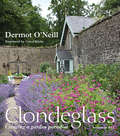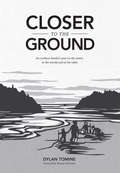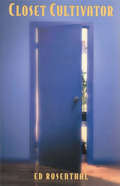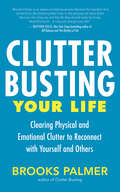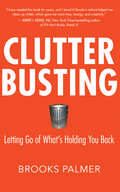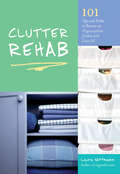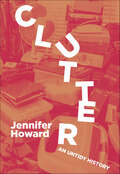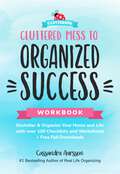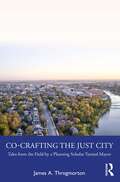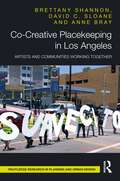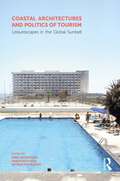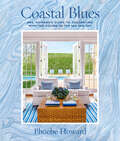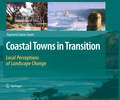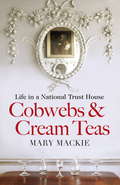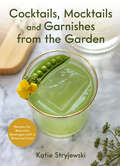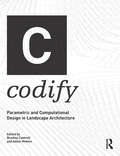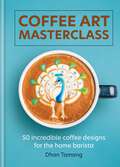- Table View
- List View
Clondeglass: Creating A Garden Paradise
by Dermot O'NeillWhen Dermot O'Neill bought Clondeglass over a decade ago, the derelict house and totally overgrown walled garden were on the edge of collapse. Here, Dermot takes us on a tour of the different sections of the totally renovated garden, showing his particular plant passions and interests, covering trees, shrubs, perennials, bulbs and structures. We start in the Rose Garden, exploring the wide range of roses, before moving onto the Double Borders and Courtyard. Inside the Polytunnel we find a host of vegetables and more tropical plants. Then along the West Border we come to The Temple, a timber haven to relax and escape the rain! The Potager is devoted to vegetables and fruit trees, including a number of rare species and Irish heritage varieties. Finally The Poultry, with Dermot's own Toulouse geese. Remarkable before and after photographs document the enormous changes, as well as plans to show what's still to come.
Clondeglass: Creating a Garden Paradise
by Dermot O'NeillWhen Dermot O'Neill bought Clondeglass over a decade ago, the derelict house and totally overgrown walled garden were on the edge of collapse. Here, Dermot takes us on a tour of the different sections of the totally renovated garden, showing his particular plant passions and interests, covering trees, shrubs, perennials, bulbs and structures. We start in the Rose Garden, exploring the wide range of roses, before moving onto the Double Borders and Courtyard. Inside the Polytunnel we find a host of vegetables and more tropical plants. Then along the West Border we come to The Temple, a timber haven to relax and escape the rain! The Potager is devoted to vegetables and fruit trees, including a number of rare species and Irish heritage varieties. Finally The Poultry, with Dermot's own Toulouse geese. Remarkable before and after photographs document the enormous changes, as well as plans to show what's still to come.
Closer to the Ground
by Thomas Mcguane Nikki Mcclure Dylan TomineCloser to the Ground is the deeply personal story of a father learning to share his love of nature with his children, not through the indoor lens of words or pictures, but directly, palpably, by exploring the natural world as they forage, cook and eat from the woods and sea. With illustrations by Nikki McClure.This compelling, masterfully written tale follows Dylan Tomine and his family through four seasons as they hunt chanterelles, fish for salmon, dig clams and gather at the kitchen table, mouths watering, to enjoy the fruits of their labor. Closer to the Ground captures the beauty and surprise of the natural world-and the ways it teaches us how to live-with humor, gratitude and a nose for adventure as keen as a child's. It is a book filled with weather, natural history and many delicious meals.
Closet Cultivator
by Ed RosenthalWritten in clear, easy-to-understand language for the novice grower, Closet Cultivator is the ultimate secret growing guide. The author discusses lighting, nutrients, water systems, potency, and more, and he shows how to establish a high-yield garden in a limited space -- and on a limited budget.
Closet Cultivator: Growing Marijuana Indoors
by Ed RosenthalWritten in clear, easy-to-understand language for the novice grower, Closet Cultivator is the ultimate secret growing guide. The author discusses lighting, nutrients, water systems, potency, and more, and he shows how to establish a high-yield garden in a limited space -- and on a limited budget.
Clutter Busting Your Life
by Brooks PalmerOver the course of his career helping people let go of things they no longer need, Brooks Palmer has been struck by the many ways that clutter affects relationships. In these pages, he shows how we use clutter to protect ourselves, control others, and cling to the past, and how it keeps us from experiencing the joy of connection. With insight-prompting questions, exercises, client examples, and even whimsical line drawings, Palmer will take you from overwhelmed to empowered. His gentle guidance will help you to not only clear clutter from your home but also enjoy deeper, more authentic, and clutter-free relationships of all kinds.
Clutter Busting: Letting Go of What's Holding You Back
by Brooks PalmerPiles of junk in garages and closets, overflowing papers on desks, items unused for years, masses of unanswered email, clothing never worn, useless gifts that collect dust; all these things, says Brooks Palmer, come weighted with shame and guilt and have a suffocating effect on spirit and soul. In this insightful book, Palmer shows how to get rid of the things in our lives that no longer serve us. By tossing out these unneeded items, we are also eliminating their negative influences, freeing up energy, and unlocking our potential. Loaded with inspiring anecdotes and practical tips, Clutter Busting is based on the premise that your things are not sacred, but you are. The book explores such fundamental topics as the false identities we assume through clutter, the fear of change those junk piles represent, the addictive nature of holding on to objects, how clearing clutter makes room for clarity and sweeps away confusion and stasis, and much more. With Brooks’s upbeat and compassionate guidance, you’ll find yourself clearing the way for new and exciting things to come into your life.
Clutter Control
by Jeff CampbellLearn how to make the most of available space, set up practical anti-clutter systems, organize hot spot storage and find storage space in places you never dreamed of.NOTE: This edition does not include illustrations.
Clutter Rehab: 101 Tips and Tricks to Become an Organization Junkie and Love It!
by Laura WittmannCUT THE CLUTTER AND TAKE CONTROL OF YOUR HOME!With 101 quick-and-easy projects for organizing your bathroom, kitchen, closet and more, Clutter Rehab takes the stress out of home organizing. As you painlessly tackle piles of toys, stacks of paper and over-spilling drawers, you'll discover how to make de-cluttering your home an addictive pleasure. #10 Remember in Pictures.Take a snapshot of sentimental keepsakes you don't use, then donate or even sell them for cash #26 Be Grocery Smart.Save fridge and pantry space-and money!-by buying only those items on your weekly meal planner #32 Go Green.Repurpose empty cardboard, plastic and glass containers into free organizers for all your stuff #56 Childhood Archives.Sort homework, artwork and other kid creations into easy-to-shelve, keep-forever binders
Clutter: An Untidy History
by Jennifer Howard&“A brilliant and beautiful meditation on the nature of our attachment to things. Reading Clutter made me long for a life without clutter.&” —Malcolm Gladwell, New York Times–bestselling author and host of the Revisionist History podcast &“I&’m sitting on the floor in my mother&’s house, surrounded by stuff.&” So begins Jennifer Howard&’s Clutter, an expansive assessment of our relationship to the things that share and shape our lives. Sparked by the painful two-year process of cleaning out her mother&’s house in the wake of a devastating physical and emotional collapse, Howard sets her own personal struggle with clutter against a meticulously researched history of just how the developed world came to drown in material goods. With sharp prose and an eye for telling detail, she connects the dots between the Industrial Revolution, the Sears & Roebuck catalog, and the Container Store, and shines unsparing light on clutter&’s darker connections to environmental devastation and hoarding disorder. In a confounding age when Amazon can deliver anything at the click of a mouse and decluttering guru Marie Kondo can become a reality TV star, Howard&’s bracing analysis has never been timelier. &“In her stern and wide-ranging new manifesto, Clutter: An Untidy History, journalist Jennifer Howard takes the anti-clutter message a step further. Howard argues that decluttering is not just a personally liberating ritual, but a moral imperative, a duty we owe both to our children and to the planet.&” —Jennifer Reese, The Washington Post &“Blending her personal experience and her research, Howard creates an engaging narrative that is colored by her investment in understanding hoarding in all of its complexities.&” —Linda Levitt, PopMatters
Cluttered Mess to Organized Success Workbook: Declutter & Organize Your Home and Life with over 100 Checklists and Worksheets + Free Full Downloads (Clutterbug)
by Cassandra AarssenStart your decluttering project today with the bestselling workbook from the host of HGTV&’s Hot Mess House!Do you dream of getting organized, but have no idea where to start? Cluttered Mess to Organized Success: Declutter and Organize your Home and Life with over 100 Checklists and Worksheets offers you everything you need to organize your home, your family, and your time. This book doesn&’t just provide helpful tips and advice—it&’s jam packed with over 100 worksheets, forms, labels, schedules, and everything else you need to organize your life.Declutter your way to happiness with Cassandra Aarssen, Professional Organizer and creator of the popular blog and YouTube channel ClutterBug. After struggling for years with chaos and clutter, Cassandra transformed her home and her life through organization. Now she helps others get control of their clutter—and fall in love with their home all over again.
Co-Crafting the Just City: Tales from the Field by a Planning Scholar Turned Mayor
by James A. ThrogmortonThe 2016 election in Iowa City would provide an opportunity that planning faculty have long desired: the opportunity for one of their own to serve as mayor. In this new book, former Iowa City Mayor and Professor Emeritus James A. Throgmorton provides readers a sense of what democratically-elected city council members and mayors in the United States do and what it feels like to occupy and enact those roles. He does so by telling a set of “practice stories” focusing primarily, but not exclusively, on what he, a retired planning professor at the University of Iowa, experienced and learned as a council member from 2012 through 2019 and, simultaneously, as mayor from 2016 through 2019. The book proposes a practical, action-oriented theory about how city futures are being (and can be) shaped, showing that storytelling of various kinds plays a very important but poorly understood role in the co-crafting process, and demonstrating that skillful use of ethically-sound persuasive storytelling (especially by mayors) can improve our collective capacity to create better places. The book documents efforts to alleviate race-related inequities, increase the supply of affordable housing, adopt an ambitious climate action plan, improve relationships between city government and diverse marginalized communities, pursue more inclusive and sustainable land development codes/policies, and more. It will be of great interest to urban planning faculty and students and elected officials looking to collaboratively craft better cities for the future.
Co-Creative Placekeeping in Los Angeles: Artists and Communities Working Together (Routledge Research In Planning And Urban Design Ser.)
by Brettany Shannon David C. Sloane Anne BrayCo-Creative Placekeeping in Los Angeles is a novel examination of Los Angeles-based socially engaged art (SEA) practitioners’ equitable placekeeping efforts. A new concept, equitable placekeeping describes the inclination of historically marginalized community members to steward their neighborhood’s development, improve local amenities, engage in social and cultural production, and assert a mutual sense of self-definition—and the efforts of SEA artists to aid them. Emerging from in-depth interviews with eight Southern California artists and teams, Co-Creative reveals how artists engage community members, sustain relationships, and defy the presumption that residents cannot speak for themselves. Drawing on these artists and theoretical analysis of their praxes, the book explicates equitable community engagement by exploring not just the creative projects but also the underlying phenomena that inspire and sustain them: community, engagement, relationships, and defiance. What further sets this book apart is how it deviates from the conventional who and what of SEA projects to foreground the how and the why that inspire and necessitate collectively creative action. Co-Creative is for anyone studying arts-based community development and gentrification, given it complicates and enriches the current conversation about art’s undeniable and increasingly controversial role in neighborhood change. It will also be of interest to researchers and students of urban studies.
Coastal Architectures and Politics of Tourism: Leisurescapes in the Global Sunbelt
by Sibel BozdoǧanThis volume offers a critical and complicated picture of how leisure tourism connected the world after the World War II, transforming coastal lands, traditional societies, and national economies in new ways. The 21 chapters in this book analyze selected case studies of architectures and landscapes around the world, contextualizing them within economic geographies of national development, the geopolitics of the Cold War, the legacies of colonialism, and the international dynamics of decolonization. Postwar leisure tourism evokes a rich array of architectural spaces and altered coastal landscapes, which is explored in this collection through discussions of tourism developments in the Mediterranean littoral, such as Greece, Turkey, and southern France, as well as compelling analyses of Soviet bloc seaside resorts along the Black Sea and Baltic coasts, and in beachscapes and tourism architectures of western and eastern hemispheres, from Southern California to Sri Lanka, South Korea, and Egypt. This collection makes a compelling argument that "leisurescapes," far from being supra-ideological and apolitical spatial expressions of modernization, development, and progress, have often concealed histories of conflict, violence, social inequalities, and environmental degradation. It will be of interest to architectural and urban historians, architects and planners, as well as urban geographers, economic and environmental historians.
Coastal Architectures and Politics of Tourism: Leisurescapes in the Global Sunbelt
by Sibel BozdoǧanThis volume offers a critical and complicated picture of how leisure tourism connected the world after the World War II, transforming coastal lands, traditional societies, and national economies in new ways.The 21 chapters in this book analyze selected case studies of architectures and landscapes around the world, contextualizing them within economic geographies of national development, the geopolitics of the Cold War, the legacies of colonialism, and the international dynamics of decolonization. Postwar leisure tourism evokes a rich array of architectural spaces and altered coastal landscapes, which is explored in this collection through discussions of tourism developments in the Mediterranean littoral, such as Greece, Turkey, and southern France, as well as compelling analyses of Soviet bloc seaside resorts along the Black Sea and Baltic coasts, and in beachscapes and tourism architectures of western and eastern hemispheres, from Southern California to Sri Lanka, South Korea, and Egypt. This collection makes a compelling argument that "leisurescapes," far from being supra-ideological and apolitical spatial expressions of modernization, development, and progress, have often concealed histories of conflict, violence, social inequalities, and environmental degradation. It will be of interest to architectural and urban historians, architects and planners, as well as urban geographers, economic and environmental historians.
Coastal Blues: Mrs. Howard's Guide to Decorating with the Colors of the Sea and Sky
by Phoebe HowardBlue knows no bounds. “Through Howard’s eye, casual elegance meets sophisticated ease, which is revealed through several sea-inspired residences.” —Atlanta Homes & LifestylesFrom design expert (and interior design readers’ favorite) Phoebe Howard comes a new book focused on decorating with beautiful blue color schemes. Coastal Blues is a glorious decor book filled with inspiring images of beach houses, seacoast getaways, vacation cottages, and luxurious seaside manors. It is also a hardworking how-to-get-the-look book that offers solid interior design and styling advice. Featuring brand-new, never-before-published projects, every page reflects the ease and casual elegance of shoreline living. With chapters such as Sea Glass (brilliant blue color schemes), Indigo Bay (true blue schemes), and Ocean Mist (pale blue schemes), Phoebe Howard shows design lovers how to make the coastal style modern, fresh, and very much their own.“Incorporate blue and white into your kitchen and dining area by sticking with white cabinetry but adding splashes of cerulean, azure, and aquamarine on everything from curtains to counter stools, backsplash tiles to bowls. When designing with this classic color combo, you can’t have too much of a good thing.” —Maine Home + Design
Coastal Towns in Transition: Local Perceptions of Landscape Change
by Raymond James GreenMany coastal areas around the world are experiencing dramatic landscape changes as a result of increased tourism development and the "sea change phenomenon" - the migration of affluent urbanites to small coastal towns seeking beautiful, natural surroundings. In response to these changes local residents in these places often complain that the distinctive character of their towns and/or individual neighborhoods is being lost or degraded. Coastal Towns in Transition looks at how changes due to unsympathetic development of the built environment and modification of the natural landscape are perceived to negatively impact on the character of small coastal towns. The book explores the concept of town character, and associated notions of sense of place, genius loci and place identity, as conceptualised by local residents in several coastal town communities along Australia's Great Ocean Road. Findings of a four-year study involving over 1800 respondents from these communities are used to explore theoretical and methodological issues associated with the assessment of place character in the context of coastal towns that are experiencing rapid environmental change. This book will be of interest to planners and environmental designers, as well as scholars in both landscape studies and social science and planning fields who are interested in the sustainable development of coastal areas. The case studies and associated planning and design strategies, together with the bibliography of selected relevant literature, will provide an invaluable reference for these scholars.
Cobwebs and Cream Teas
by Mary MackieA warm and funny account of what it is like to live in and run a National Trust house: Felbrigg Hall in Norfolk.When Mary Mackie's husband became Houseman at Felbrigg Hall in Norfolk she suddenly found herself running one of the most elegant 17th-century houses in East Anglia. During their first year living in the National Trust house she was endlessly running up and down corridors, making visitors welcome, keeping unwelcome visitors at bay, arranging concerts, dinners and vast cleaning programmes. But leavening all the hard work were the exciting discoveries - hidden staircases, treasures in the attic and an ice house in the woods. COBWEBS AND CREAM TEAS reveals the tribulations and excitement that occur in any house open to the public, and it assures us that living in a National Trust house provides only the certainty that life will never be dull, or idle, again.
Cobwebs and Cream Teas
by Mary MackieA warm and funny account of what it is like to live in and run a National Trust house: Felbrigg Hall in Norfolk.When Mary Mackie's husband became Houseman at Felbrigg Hall in Norfolk she suddenly found herself running one of the most elegant 17th-century houses in East Anglia. During their first year living in the National Trust house she was endlessly running up and down corridors, making visitors welcome, keeping unwelcome visitors at bay, arranging concerts, dinners and vast cleaning programmes. But leavening all the hard work were the exciting discoveries - hidden staircases, treasures in the attic and an ice house in the woods. COBWEBS AND CREAM TEAS reveals the tribulations and excitement that occur in any house open to the public, and it assures us that living in a National Trust house provides only the certainty that life will never be dull, or idle, again.
Cocktails, Mocktails, and Garnishes from the Garden: Recipes for Beautiful Beverages with a Botanical Twist
by Katie StryjewskiBotany for Bartenders“Cocktails, Mocktails and Garnishes from the Garden is perfect for stirring things up and taking your drinks to a new level.” —The Two Classy Chics#1 New release in Garnishing Meals, and Food ScienceStep inside a bartender’s apothecary, forage for garnishes, and craft some of the most popular cocktails, mocktails, and beverages. This beautifully photographed compendium of craft cocktails includes examples of garnishes and interesting ingredients to give any drink a botanical twist.The go-to reference for classic and modern cocktail recipes. Whether it’s adding a basil sprig or infusing gin with peaches; Cocktails, Mocktails and Garnishes from the Garden gives you the ability to make classic cocktails and the confidence to craft innovative concoctions. Alongside recipes of some of the most popular cocktails come new-fangled libations, non-alcoholic equivalents, and instructions to create gorgeous garnishes.Creating your very own herb bar and garnish garden for craft cocktails. A cocktail recipe book from the wild; Cocktails, Mocktails and Garnishes from the Garden features examples of garnishes and general know-how. With a reference guide of herbal and floral flavors that complement different spirits, and details about what to plant and how to grow your very own herb bar, you can craft cocktail recipes alongside nature.Inside, learn about herbs and their uses as well as:General instructions on creating a garnish gardenThe difference between a high ball and a coupe glassWhich bar tools are “must haves” for a home cocktail set-upIf you enjoyed books like The Drunken Botanist, The Wildcrafting Brewer, Shrubs, or Beautiful Booze, then you’ll love Cocktails, Mocktails and Garnishes from the Garden.
Coconut Palm Frond Weaving
by William H. Goodloe Ellen GoodloeLearn the art of palm weaving with this fun Hawaiian craft book.Based on years of meticulous study and practice, the book explains in clear, easy-to understand instructions how to obtain and prepare coconut palm fronds suitable for weaving into hats, baskets, epergnes, mats, birds, and various decorations. More than 100 easy-to-follow diagrams and sketches give the reader exact, detailed instructions on weaving procedures, and provide countless ideas to inspire the imagination of the creator. After mastering the basic principles of frond weaving, the reader will be able to duplicate almost any woven object or execute his own designs, whether in coconut palm fronds or with fronds from other types of palm trees and palmettos.The weaving itself takes no unusual physical prowess. In fact, frond weaving is well suited to the needs of both recreational craft and physical therapy programs, as well as the general hobbyist. With a little patience and effort, a novice weaver can acquire the skills of an ancient art which is as uncomplicated as it is beautiful.This economical and delightfully presented volume will be a valued addition to the literature of traditional handicrafts, a book that recreation libraries and all craft enthusiasts will welcome.
Cocoon: Creating Homes with Heart
by Ali HeathPRAISE FOR COCOON'Cocoon is an inspiring exploration of home as a sanctuary, celebrating the beauty of spaces that nurture and provide comfort. Ali has an intuitive understanding of the meaning of home, encouraging others to live with the things they love and to celebrate their individuality.' Chrissie Rucker - Founder @thewhitecompany'Another stunning design book! Ali Heath's books never fail to inspire me.'Leanne Ford @leannefordinteriors'Ali Heath understands that true sanctuary isn't about having the right things, but about surrounding ourselves with what genuinely nourishes us. Cocoon beautifully captures this essence of intentional living through spaces that prioritize comfort, connection, and personal meaning over perfection.'Shira Gill, author of Minimalista'Ali Heath is not only a gifted writer, interior stylist, and mentor but also a warm-hearted woman and a cherished friend. Her sensitivity to moods, emotions, and creativity is something truly special. In her latest book, COCOON, she takes us into lived-in homes and spaces that feel deeply personal. Her style is romantic, tactile, and carefully curated, with each piece exuding a vintage charm. The blend of decor, antiques, books, art, and furniture creates a seamless narrative of a life well lived. There's not a single page where you wouldn't want to linger.' Malene Birger @malenebirgers_world 'Cosseting, cosy, sink-into spaces are on the rise and there is no better book to dive into and learn how to pull them off than Ali Heath's Cocoon: Creating Homes with Heart. It's an essential read that not only will put a smile on your face as you settle down and dig in it will awaken your senses exciting you to create visual, tactile, cosy havens that you never want to leave.' Abigail Ahern @abigailahern'Ali's desire to help us all create a sanctuary at home focuses on the importance of human connections and an awareness of our senses. Making spaces that we can connect with intuitively goes way beyond just aesthetics as these case studies illustrate so perfectly.' Kate Watson Smyth, KateWatsonSmyth.Substack.com***In her third book, Cocoon: Creating Homes with Heart, Ali Heath, invites the reader to create a home sanctuary that focuses on the human touch, as an antidote to our fast-paced, tech-driven modern world. This way of decorating is so much more than just a look or style - it's about taking a holistic approach that draws upon all our senses, not just the visual, and connects us more meaningfully to ourselves and our surroundings. In the past creating a sanctuary was about the decoration of a few key rooms, now it is about how the whole home makes us feel.Cocooning is not about isolation or shutting down and does not have to mean going off-grid - it is simply about tuning back into our emotions and creativity to satisfy our need for comfort and wonder. Divided into three informative chapters: Cocooning, Feeling and Living, the book explores the homes of 13 creatives from around the world, including architects, antique dealers, furniture makers and artists in the UK, France, Spain, Italy and Australia. With everything from small inner-city sanctuaries to spacious island retreats, Cocoon celebrates a design approach that speaks to the heart.
Cocoon: Creating Homes with Heart
by Ali HeathPRAISE FOR COCOON'Cocoon is an inspiring exploration of home as a sanctuary, celebrating the beauty of spaces that nurture and provide comfort. Ali has an intuitive understanding of the meaning of home, encouraging others to live with the things they love and to celebrate their individuality.' Chrissie Rucker - Founder @thewhitecompany'Another stunning design book! Ali Heath's books never fail to inspire me.'Leanne Ford @leannefordinteriors'Ali Heath understands that true sanctuary isn't about having the right things, but about surrounding ourselves with what genuinely nourishes us. Cocoon beautifully captures this essence of intentional living through spaces that prioritize comfort, connection, and personal meaning over perfection.'Shira Gill, author of Minimalista'Ali Heath is not only a gifted writer, interior stylist, and mentor but also a warm-hearted woman and a cherished friend. Her sensitivity to moods, emotions, and creativity is something truly special. In her latest book, COCOON, she takes us into lived-in homes and spaces that feel deeply personal. Her style is romantic, tactile, and carefully curated, with each piece exuding a vintage charm. The blend of decor, antiques, books, art, and furniture creates a seamless narrative of a life well lived. There's not a single page where you wouldn't want to linger.' Malene Birger @malenebirgers_world 'Cosseting, cosy, sink-into spaces are on the rise and there is no better book to dive into and learn how to pull them off than Ali Heath's Cocoon: Creating Homes with Heart. It's an essential read that not only will put a smile on your face as you settle down and dig in it will awaken your senses exciting you to create visual, tactile, cosy havens that you never want to leave.' Abigail Ahern @abigailahern'Ali's desire to help us all create a sanctuary at home focuses on the importance of human connections and an awareness of our senses. Making spaces that we can connect with intuitively goes way beyond just aesthetics as these case studies illustrate so perfectly.' Kate Watson Smyth, KateWatsonSmyth.Substack.com***In her third book, Cocoon: Creating Homes with Heart, Ali Heath, invites the reader to create a home sanctuary that focuses on the human touch, as an antidote to our fast-paced, tech-driven modern world. This way of decorating is so much more than just a look or style - it's about taking a holistic approach that draws upon all our senses, not just the visual, and connects us more meaningfully to ourselves and our surroundings. In the past creating a sanctuary was about the decoration of a few key rooms, now it is about how the whole home makes us feel.Cocooning is not about isolation or shutting down and does not have to mean going off-grid - it is simply about tuning back into our emotions and creativity to satisfy our need for comfort and wonder. Divided into three informative chapters: Cocooning, Feeling and Living, the book explores the homes of 13 creatives from around the world, including architects, antique dealers, furniture makers and artists in the UK, France, Spain, Italy and Australia. With everything from small inner-city sanctuaries to spacious island retreats, Cocoon celebrates a design approach that speaks to the heart.
Codify: Parametric and Computational Design in Landscape Architecture
by Bradley Cantrell Adam MekiesCodify: Parametric and Computational Design in Landscape Architecture provides a series of essays that explore what it means to use, modify and create computational tools in a contemporary design environment. Landscape architecture has a long history of innovation in the areas of computation and media, particularly in how the discipline represents, analyses, and constructs complex systems. This curated volume spans academic and professional projects to form a snapshot of digital practices that aim to show how computation is a tool that goes beyond methods of representation and media. The book is organized in four sections; syntax, perception, employ, and prospective. The essays are written by leading academics and professionals and the sections examine the role of computational tools in landscape architecture through case studies, historical accounts, theoretical arguments, and nascent propositions.
Coffee Art Masterclass: 50 incredible coffee designs for the home barista
by Dhan TamangTake your coffee art to the next level with 50 spectacular-yet-simple latte art designs to impress family and friends. From the comfort of your own kitchen you can recreate great paintings, pour and etch stunning natural wonders, iconic buildings and fantastical creatures. No special equipment is needed and once you've mastered the basics a world of incredible coffee art awaits you.Coffee Art Masterclass includes next-level latte designs that everyone can achieve.
